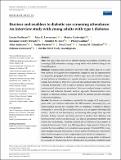Barriers and enablers to diabetic eye screening attendance : an interview study with young adults with type 1 diabetes
Abstract
Aim To identify barriers and enablers of diabetic eye screening (DES) attendance amongst young adults with diabetes living in the UK. Methods Semi-structured qualitative interviews with adults aged 18-34 years with diabetes. Participants were purposively sampled to aim for representation across gender, geographical locations, diabetes type, years since diabetes diagnosis and patterns of attendance (i.e. regular attenders, occasional non-attenders, regular non-attenders). Data were collected and analysed using the Theoretical Domains Framework (TDF) to explore potential individual, socio-cultural and environmental influences on attendance. Data were analysed using a combined deductive and inductive thematic analysis approach. Barriers/enablers were mapped to behaviour change techniques (BCTs) to identify potential strategies to increase attendance. Results Key barriers to attendance reported by the sample of 29 study participants with type 1 diabetes, fell within the TDF domains: [1] (e.g. not understanding reasons for attending DES or treatments available if diabetic retinopathy is detected), [Social Influences] (e.g. lack of support following DES results), [Social role and Identity] (e.g. not knowing other people their age with diabetes, feeling ‘isolated’ and being reluctant to disclose their diabetes) and [Environmental Context and Resources] (e.g. lack of appointment flexibility and options for rescheduling). Enablers included: [Social Influences] (e.g. support of family/diabetes team), [Goals] (e.g. DES regarded as ‘high priority’). Many of the reported barriers/enablers were consistent across groups. Potential BCTs to support attendance include: Instructions on how to perform the behaviour; Information about health consequences; Social support (practical) and Social comparison. Conclusions Attendance to diabetic eye screening in young adults is influenced by a complex set of interacting factors. Identification of potentially modifiable target behaviours provides a basis for designing more effective, tailored interventions to help young adults regularly attend eye screening and prevent avoidable vision loss.
Citation
Prothero , L , Lawrenson , J G , Cartwright , M , Crosby-Nwaobi , R , Burr , J M , Gardner , P , Anderson , J , Presseau , J , Ivers , N , Grimshaw , J M , Lorencatto , F & The EROS Study Investigators 2022 , ' Barriers and enablers to diabetic eye screening attendance : an interview study with young adults with type 1 diabetes ' , Diabetic Medicine , vol. 39 , no. 3 , e14751 . https://doi.org/10.1111/dme.14751
Publication
Diabetic Medicine
Status
Peer reviewed
ISSN
0742-3071Type
Journal article
Description
Funding: NIHR Policy Research Program (project reference PR-R20-0318-22001).Collections
Items in the St Andrews Research Repository are protected by copyright, with all rights reserved, unless otherwise indicated.

